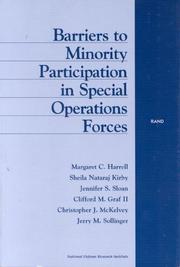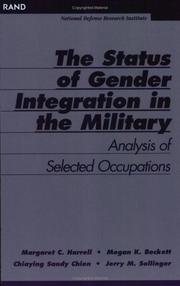| Listing 1 - 10 of 23 | << page >> |
Sort by
|

ISBN: 0833032518 0585388636 9780585388632 9780833032515 9780833028808 0833028804 Year: 2000 Publisher: Santa Monica, Calif. RAND
Abstract | Keywords | Export | Availability | Bookmark
 Loading...
Loading...Choose an application
- Reference Manager
- EndNote
- RefWorks (Direct export to RefWorks)
Army spouses --- Army wives --- Military spouses --- United States. --- U.S. Army --- US Army --- Military life.
Book
Year: 2009 Publisher: Santa Monica, CA : RAND,
Abstract | Keywords | Export | Availability | Bookmark
 Loading...
Loading...Choose an application
- Reference Manager
- EndNote
- RefWorks (Direct export to RefWorks)
In the current report, we use data from the 2005 survey to examine the demand for and supply of 'jointness' in billets. The report focuses on three areas: (1) analyzing the characteristics that measure 'jointness' of a billet and using that analysis to identify billets with joint content; (2) determining whether sufficient numbers of officers with joint education, training, and experience are likely to be available to satisfy DoD's needs; and (3) exploring whether and how the experiences of selected communities of officers, for example, those assigned to billets dealing with acquisition matters, differ from those of their peers.
Unified operations (Military science) --- United States --- United States --- Armed Forces --- Officers --- Training of. --- Armed Forces --- Officers --- Management.
Book
ISBN: 1281181110 9786611181116 0833042718 0833041509 9780833042712 9781281181114 9780833041500 6611181113 Year: 2007 Publisher: Santa Monica, CA RAND National Defense Research Institute
Abstract | Keywords | Export | Availability | Bookmark
 Loading...
Loading...Choose an application
- Reference Manager
- EndNote
- RefWorks (Direct export to RefWorks)
The current U.S. Department of Defense (DoD) policy for assigning military women was issued in 1994, and the U.S. Army's assignment policy dates to 1992. In the ensuing years, the U.S. Army has undergone significant technological and organizational transformation, which has changed how it organizes and fights. There is concern that, in the course of operations in Iraq, the Army has not been adhering to its own assignment policy, as there are several important and potentially problematic differences between the DoD and Army policies. For example, the DoD policy prohibits the assignment of women
Women in combat. --- Women soldiers. --- Women in combat --- Women soldiers --- Military & Naval Science --- Law, Politics & Government --- Military Administration --- Government policy --- United States --- Armed Forces --- Women. --- Women as soldiers --- Women in the military --- Soldiers --- Combat

ISBN: 0585246491 9780585246499 9780833027535 0833027530 0833027530 Year: 1999 Publisher: Santa Monica, CA : RAND,
Abstract | Keywords | Export | Availability | Bookmark
 Loading...
Loading...Choose an application
- Reference Manager
- EndNote
- RefWorks (Direct export to RefWorks)
Special forces (Military science) --- Military & Naval Science --- Law, Politics & Government --- Military Administration --- United States --- ABŞ --- ABSh --- Ameerika Ühendriigid --- America (Republic) --- Amerika Birlăshmish Shtatlary --- Amerika Birlăşmi Ştatları --- Amerika Birlăşmiş Ştatları --- Amerika ka Kelenyalen Jamanaw --- Amerika Qūrama Shtattary --- Amerika Qŭshma Shtatlari --- Amerika Qushma Shtattary --- Amerika (Republic) --- Amerikai Egyesült Államok --- Amerikanʹ Veĭtʹsėndi︠a︡vks Shtattnė --- Amerikări Pĕrleshu̇llĕ Shtatsem --- Amerikas Forenede Stater --- Amerikayi Miatsʻyal Nahangner --- Ameriketako Estatu Batuak --- Amirika Carékat --- AQSh --- Ar. ha-B. --- Arhab --- Artsot ha-Berit --- Artzois Ha'bris --- Bí-kok --- Ē.P.A. --- EE.UU. --- Egyesült Államok --- ĒPA --- Estados Unidos --- Estados Unidos da América do Norte --- Estados Unidos de América --- Estaos Xuníos --- Estaos Xuníos d'América --- Estatos Unitos --- Estatos Unitos d'America --- Estats Units d'Amèrica --- Ètats-Unis d'Amèrica --- États-Unis d'Amérique --- Fareyniḳṭe Shṭaṭn --- Feriene Steaten --- Feriene Steaten fan Amearika --- Forente stater --- FS --- Hēnomenai Politeiai Amerikēs --- Hēnōmenes Politeies tēs Amerikēs --- Hiwsisayin Amerikayi Miatsʻeal Tērutʻiwnkʻ --- Istadus Unidus --- Jungtinės Amerikos valstybės --- Mei guo --- Mei-kuo --- Meiguo --- Mî-koet --- Miatsʻyal Nahangner --- Miguk --- Na Stàitean Aonaichte --- NSA --- S.U.A. --- SAD --- Saharat ʻAmērikā --- SASht --- Severo-Amerikanskie Shtaty --- Severo-Amerikanskie Soedinennye Shtaty --- Si︠e︡vero-Amerikanskīe Soedinennye Shtaty --- Sjedinjene Američke Države --- Soedinennye Shtaty Ameriki --- Soedinennye Shtaty Severnoĭ Ameriki --- Soedinennye Shtaty Si︠e︡vernoĭ Ameriki --- Spojené staty americké --- SShA --- Stadoù-Unanet Amerika --- Stáit Aontaithe Mheiriceá --- Stany Zjednoczone --- Stati Uniti --- Stati Uniti d'America --- Stâts Unîts --- Stâts Unîts di Americhe --- Steatyn Unnaneysit --- Steatyn Unnaneysit America --- SUA (Stati Uniti d'America) --- Sŭedineni amerikanski shtati --- Sŭedinenite shtati --- Tetã peteĩ reko Amérikagua --- U.S. --- U.S.A. --- United States of America --- Unol Daleithiau --- Unol Daleithiau America --- Unuiĝintaj Ŝtatoj de Ameriko --- US --- USA --- Usono --- Vaeinigte Staatn --- Vaeinigte Staatn vo Amerika --- Vereinigte Staaten --- Vereinigte Staaten von Amerika --- Verenigde State van Amerika --- Verenigde Staten --- VS --- VSA --- Wááshindoon Bikéyah Ałhidadiidzooígíí --- Wilāyāt al-Muttaḥidah --- Wilāyāt al-Muttaḥidah al-Amirīkīyah --- Wilāyāt al-Muttaḥidah al-Amrīkīyah --- Yhdysvallat --- Yunaeted Stet --- Yunaeted Stet blong Amerika --- ZDA --- Združene države Amerike --- Zʹi︠e︡dnani Derz︠h︡avy Ameryky --- Zjadnośone staty Ameriki --- Zluchanyi︠a︡ Shtaty Ameryki --- Zlucheni Derz︠h︡avy --- ZSA --- Η.Π.Α. --- Ηνωμένες Πολιτείες της Αμερικής --- Америка (Republic) --- Американь Вейтьсэндявкс Штаттнэ --- Америкӑри Пӗрлешӳллӗ Штатсем --- САЩ --- Съединените щати --- Злучаныя Штаты Амерыкі --- ولايات المتحدة --- ولايات المتّحدة الأمريكيّة --- ولايات المتحدة الامريكية --- 미국 --- Armed Forces --- Minorities. --- Spojené obce severoamerické --- États-Unis --- É.-U. --- ÉU
Book
Year: 2011 Publisher: Santa Monica, CA : RAND Corporation,
Abstract | Keywords | Export | Availability | Bookmark
 Loading...
Loading...Choose an application
- Reference Manager
- EndNote
- RefWorks (Direct export to RefWorks)
Before Donald H. Rumsfeld entered his second tenure as Secretary of Defense in 2001, the selection of senior U.S. military officers for top-ranking positions within the Department of Defense (DoD) was largely decided within the uniformed services, and the Secretary of Defense did not typically challenge the recommendations. However, to support his goal of transforming the defense establishment, Rumsfeld decided to become personally involved in the selection process. Rumsfeld's changes resulted in a process that featured long-term succession planning, identified qualifications for senior positions, built a slate of highly qualified officers, and sought to arrive at a series of "best fit" decisions for the top military positions. The process also focused on planning for the future by identifying highly capable leaders and associating them with a series of assignments that would prepare them for the top military positions. When Rumsfeld left DoD in 2006, parts of the process he developed were retained, and others were changed significantly or discarded. The process has continued to evolve, at times rekindling some of the efforts Rumsfeld initiated but reshaping them to suit the leadership style of current DoD officials. The authors review senior leader selection and succession planning in general, describe the process developed by Rumsfeld, and investigate how the process evolved after Rumsfeld left office. In conclusion, they identify key system attributes that future DoD officials should consider as they contemplate how senior officer selection and assignments will be managed.
Leadership --- Rumsfeld, Donald, --- United States. --- Officials and employees --- Selection and appointment. --- Officers --- Management.
Book
ISBN: 1601290128 Year: 2005 Publisher: Santa Monica : RAND Corporation,
Abstract | Keywords | Export | Availability | Bookmark
 Loading...
Loading...Choose an application
- Reference Manager
- EndNote
- RefWorks (Direct export to RefWorks)
Revisits joint officer management and frames a strategic approach to further officers' development in joint matters.
Unified operations (Military science). --- United States - Armed Forces - Officers. --- United States --- Armed Forces --- Officers. --- Personnel management.
Book
ISBN: 0833083120 0833052330 9780833083128 9780833052339 Year: 2012 Publisher: Santa Monica, Calif. Rand Corporation
Abstract | Keywords | Export | Availability | Bookmark
 Loading...
Loading...Choose an application
- Reference Manager
- EndNote
- RefWorks (Direct export to RefWorks)
"Title 10 of the U.S. Code requires consideration of adverse information by all general and flag officer boards. Also, adverse information is considered within the services and by the Secretary of Defense when nominating senior officers for assignment. The Secretary of Defense must issue certifications to the President and the Senate Armed Services Committee (SASC) regarding this information. However, there is a diversity of sources and terminology used to describe events of concern and individuals involved in such events, and recent individual cases have suggested possible gaps in the processes overall. This study is intended to describe and evaluate the reporting practices of the Department of Defense (DoD) and thus ensure that consistent, reliable information supports decisions regarding the management of general and flag officers. The processes described within are complicated and there exists no single authority. Multiple representatives from each service have reviewed the descriptions of the service processes."--Preface.
Military & Naval Science --- Law, Politics & Government --- Military Administration --- United States. --- Rules and practice --- Evaluation. --- United States --- Armed Forces --- Officers --- Management. --- Discipline. --- Personnel management. --- D.O.D. --- DOD (Department of Defense) --- Mei-kuo kuo fang pu --- Ministerstvo oborony SShA --- Министерство обороны США --- National Military Establishment (U.S.) --- ABŞ --- ABSh --- Ameerika Ühendriigid --- America (Republic) --- Amerika Birlăshmish Shtatlary --- Amerika Birlăşmi Ştatları --- Amerika Birlăşmiş Ştatları --- Amerika ka Kelenyalen Jamanaw --- Amerika Qūrama Shtattary --- Amerika Qŭshma Shtatlari --- Amerika Qushma Shtattary --- Amerika (Republic) --- Amerikai Egyesült Államok --- Amerikanʹ Veĭtʹsėndi︠a︡vks Shtattnė --- Amerikări Pĕrleshu̇llĕ Shtatsem --- Amerikas Forenede Stater --- Amerikayi Miatsʻyal Nahangner --- Ameriketako Estatu Batuak --- Amirika Carékat --- AQSh --- Ar. ha-B. --- Arhab --- Artsot ha-Berit --- Artzois Ha'bris --- Bí-kok --- Ē.P.A. --- EE.UU. --- Egyesült Államok --- ĒPA --- Estados Unidos --- Estados Unidos da América do Norte --- Estados Unidos de América --- Estaos Xuníos --- Estaos Xuníos d'América --- Estatos Unitos --- Estatos Unitos d'America --- Estats Units d'Amèrica --- Ètats-Unis d'Amèrica --- États-Unis d'Amérique --- Fareyniḳṭe Shṭaṭn --- Feriene Steaten --- Feriene Steaten fan Amearika --- Forente stater --- FS --- Hēnomenai Politeiai Amerikēs --- Hēnōmenes Politeies tēs Amerikēs --- Hiwsisayin Amerikayi Miatsʻeal Tērutʻiwnkʻ --- Istadus Unidus --- Jungtinės Amerikos valstybės --- Mei guo --- Mei-kuo --- Meiguo --- Mî-koet --- Miatsʻyal Nahangner --- Miguk --- Na Stàitean Aonaichte --- NSA --- S.U.A. --- SAD --- Saharat ʻAmērikā --- SASht --- Severo-Amerikanskie Shtaty --- Severo-Amerikanskie Soedinennye Shtaty --- Si︠e︡vero-Amerikanskīe Soedinennye Shtaty --- Sjedinjene Američke Države --- Soedinennye Shtaty Ameriki --- Soedinennye Shtaty Severnoĭ Ameriki --- Soedinennye Shtaty Si︠e︡vernoĭ Ameriki --- Spojené obce severoamerické --- Spojené staty americké --- SShA --- Stadoù-Unanet Amerika --- Stáit Aontaithe Mheiriceá --- Stany Zjednoczone --- Stati Uniti --- Stati Uniti d'America --- Stâts Unîts --- Stâts Unîts di Americhe --- Steatyn Unnaneysit --- Steatyn Unnaneysit America --- SUA (Stati Uniti d'America) --- Sŭedineni amerikanski shtati --- Sŭedinenite shtati --- Tetã peteĩ reko Amérikagua --- U.S. --- U.S.A. --- United States of America --- Unol Daleithiau --- Unol Daleithiau America --- Unuiĝintaj Ŝtatoj de Ameriko --- US --- USA --- Usono --- Vaeinigte Staatn --- Vaeinigte Staatn vo Amerika --- Vereinigte Staaten --- Vereinigte Staaten von Amerika --- Verenigde State van Amerika --- Verenigde Staten --- VS --- VSA --- Wááshindoon Bikéyah Ałhidadiidzooígíí --- Wilāyāt al-Muttaḥidah --- Wilāyāt al-Muttaḥidah al-Amirīkīyah --- Wilāyāt al-Muttaḥidah al-Amrīkīyah --- Yhdysvallat --- Yunaeted Stet --- Yunaeted Stet blong Amerika --- ZDA --- Združene države Amerike --- Zʹi︠e︡dnani Derz︠h︡avy Ameryky --- Zjadnośone staty Ameriki --- Zluchanyi︠a︡ Shtaty Ameryki --- Zlucheni Derz︠h︡avy --- ZSA --- Η.Π.Α. --- Ηνωμένες Πολιτείες της Αμερικής --- Америка (Republic) --- Американь Вейтьсэндявкс Штаттнэ --- Америкӑри Пӗрлешӳллӗ Штатсем --- САЩ --- Съединените щати --- Злучаныя Штаты Амерыкі --- ولايات المتحدة --- ولايات المتّحدة الأمريكيّة --- ولايات المتحدة الامريكية --- 미국 --- États-Unis --- É.-U. --- ÉU
Book
ISBN: 9780833091383 0833091387 Year: 2015 Publisher: [Santa Monica, Calif.] RAND Corporation
Abstract | Keywords | Export | Availability | Bookmark
 Loading...
Loading...Choose an application
- Reference Manager
- EndNote
- RefWorks (Direct export to RefWorks)
Faith-based organizations (FBOs) are an important community-based resource for veterans as they readjust to civilian life. Through interviews with both national-level and smaller, local FBOs, the authors sought to understand better the current and potential roles for FBOs in veteran reintegration. Interviewees suggested that veterans may look to FBOs for support because they offer privacy and confidentiality, two features that may be especially critical when a potential stigma is involved. Some FBOs have also developed a reputation as safe places for veterans, providing supportive, judgment-free environments. FBOs not only help veterans with spiritual matters but address diverse areas of veteran health and wellness, including vocation, education, financial and legal stability, shelter, access to goods and services, mental health, access to health care, physical health, family, and social networks. In some cases, the support is offered to veterans directly; in other instances, the support is indirect, via training individuals to help veterans or educating the public about them. In the process of providing support, FBOs interact with varied organizations, including government entities, private nonprofits, and one another, for training, outreach, referrals, information exchange, obtaining donations, and collaboration. Yet challenges exist, including insufficient connections with chaplains working in different settings and others in the web of support, resource and capacity constraints, lack of awareness of experience with veterans, issues related to religious philosophy or orientation, and characteristics of veterans themselves. To move forward, the authors offer recommendations for policymakers, organizations that interact with FBOs, and FBOs themselves to help FBOs engage fully in the web of reintegration support.
Veteran reintegration --- Veterans --- Religious institutions --- Services for --- Community reintegration, Veteran --- Post-deployment reintegration --- Reintegration, Veteran --- Veteran-community reintegration --- Resocialization --- Reintegration

ISBN: 0833033794 9780833033796 9780833030931 0833030930 Year: 2002 Publisher: Santa Monica, CA Rand
Abstract | Keywords | Export | Availability | Bookmark
 Loading...
Loading...Choose an application
- Reference Manager
- EndNote
- RefWorks (Direct export to RefWorks)
Has opening new skills and units been enough to create equal opportunities for women in the US military? This work assesses the status of gender representation in US military occupations newly opened to women, focusing on specific issues for 10 selected occupations.
United States - Armed Forces - Women. --- Military Administration --- Military & Naval Science --- Law, Politics & Government --- United States --- Armed Forces --- Women. --- Occupational specialties. --- Personnel management. --- Personnel management
Book
Year: 2009 Publisher: Santa Monica, CA : RAND Corporation,
Abstract | Keywords | Export | Availability | Bookmark
 Loading...
Loading...Choose an application
- Reference Manager
- EndNote
- RefWorks (Direct export to RefWorks)
This course provides an overview of two types of qualitative data collection methodologies: semi-structured interviews and focus groups. These techniques are commonly used in policy research and are applicable to many research questions. The course does not aim to cover all the aspects of interviewing and focus groups, but rather it is designed to provide an overview of these methods, as well as some practical tools that will allow readers to improve their qualitative data collection. We acknowledge that different disciplines often speak about these research methods in different terms. For example, while some disciplines and professions may use the term "active data collection," these materials use the terms more traditionally associated with qualitative research.
| Listing 1 - 10 of 23 | << page >> |
Sort by
|

 Search
Search Feedback
Feedback About UniCat
About UniCat  Help
Help News
News